Basic Courses of Design Major Based on the ADDIE Model: Shed Light on Response to Social Trends and Needs
Abstract
1. Introduction
1.1. Research Background and Motivation
1.2. Research Purpose
2. Literature Review
2.1. Social Innovation
2.2. ADDIE Model
2.3. Learning Satisfaction
3. Course Design Methodology
3.1. Course Analysis
3.1.1. Course Uniqueness
3.1.2. Analysis of Students’ Needs
3.1.3. Classification of Course Design
3.2. Course Design
3.2.1. Determine the Participants of the Course Design
3.2.2. Determination of Course Teaching Structure
- (1)
- Interdisciplinary cooperation of teaching teachers: combination of various professional fields.
- (2)
- Transformation of teaching mode: offline education combined with online education.
- (3)
- Production and learning cooperation in the classroom: the combination of university course education and industry alliance education.
- (4)
- Social display of teaching achievements
- (5)
- Change of teaching field: the combination of teaching displays in the school and social public exhibition spaces
3.3. Course Development
3.3.1. Construction of Course Network Platform
3.3.2. Industry Association-Based Learning (IBL)
4. Course Implementation and Evaluation
4.1. Course Implementation Arrangements
4.1.1. Course Teacher Arrangement
4.1.2. Course Teaching Arrangements
4.2. Course Evaluation
4.2.1. Research Sample
4.2.2. Composition of Questionnaire
4.2.3. Data Analysis
- (1)
- Reliability Analysis (Cronbach’s alpha)
- (2)
- Analysis of Questionnaire Data
5. Discussion and Conclusions
5.1. Discussion
5.2. Course Work
5.3. Conclusions
- (1)
- Course adjustment
- (2)
- Teaching teambuilding
- (3)
- Construction of the social cooperation platform
Author Contributions
Funding
Institutional Review Board Statement
Informed Consent Statement
Data Availability Statement
Conflicts of Interest
References
- Norman, D. Why (Art and) Design Education Must Change. Core77. 26 November. Available online: http://www.core77.com/blog/columns/whydesigneducationmustchange (accessed on 1 October 2019).
- Manzini, E. Design, When Everybody Designs: An Introduction to Design for social Innovation, 1st ed.; MIT Press: Cambridge, MA, USA, 2015; ISBN 9780262028608. [Google Scholar]
- Berk, S. Designing for the Future of Education Requires Design Education. Art Educ. 2016, 69, 16–20. [Google Scholar] [CrossRef]
- Meyer, M.; Norman, D. Changing Design Education for the 21st Century. She Ji J. Des. Econ. Innov. 2020, 6, 13–49. [Google Scholar] [CrossRef]
- Wang, X. Interdisciplinary View on Design Education. In Proceedings of the Academy for Design Innovation Management, London, UK, 19–21 June 2019; Volume 1, pp. 59–72. [Google Scholar]
- Griffiths, R. Design education: Ensuring course content and delivery is relevant to the needs of industry. In Proceedings of the 8th International Conference on Engineering and Product Design Education, Salzburg, Austria, 7–8 September 2006; pp. 63–68. [Google Scholar]
- Zhang, L.H. Teaching is Reflective Training to Find Design Solutions. Design 2019, 4, 73–75. [Google Scholar]
- Zhang, D.D.; Xie, H.L. Chinese Industrial Design Education in the View of Internationalization and Digitization: Interview with Professor He Renke. Zhuangshi 2019, 5, 40–44. [Google Scholar]
- Molenda, M. In Search of the Elusive ADDIE Model. Perform. Improv. 2003, 5, 40–43. [Google Scholar] [CrossRef]
- Lee, S.H.; Tseng, H.C. Investigation of technology integrated instruction in art education: A case study of exploring learning achievement. J. Educ. Multimed. Hypermedia 2008, 17, 337–361. [Google Scholar]
- Mcauley, A.; Stewart, B.; Cormier, D.; Siemens, G. The MOOC Model for Digital Practice. 2010. Available online: https://d1wqtxts1xzle7.cloudfront.net/43171365/MOOC_Final.pdf?1456693335=&response-content-disposition=inline%3B+filename%3DThe_MOOC_model_for_digital_practice.pdf&Expires=1618299466&Signature=DZe8sFhseCqVOJ~daYk2biJoDsywwhLZ4EzN0OZZhOV7J29S7rEPhfKLn82XQB8NPBgJldXm4tfrDMojtdJDyLW6EO93NJ68wgzN8I2LW6tcN56WaNT7U6yP7TGR06SEQWiLw8b6~NvoaMni0PhwPtHbr8mZbeIi~qKM1RCMeeYPTpzkesl3RITT0EqHhizS~JM4MnehPrgEODXKIBIjeVe9W0Aw~zgBd8OPwXoZwk~EhIDR9TfDjc3ZRZz30Yf7bQYxpZ5lJWdZoZK06rzTzKFXny~5y~MskI29pHpfEaqLUSXlMYH02OzJH7KHK4~IHIHlqlEQ-Gqrn4UcAHZ7FA__&Key-Pair-Id=APKAJLOHF5GGSLRBV4ZA (accessed on 1 October 2019).
- Wikipedia. Model Online Course. Available online: https://zh.wikipedia.org (accessed on 2 October 2019).
- Papanek, V. Design for the Real World: Human Ecology and Social Change, 1st ed.; Pantheon Books: New York, NY, USA, 1971; ISBN 0-394-47036-2. [Google Scholar]
- Murray, R.; Caulier-Grice, J.; Mulgan, G. The Open Book of Social Innovation: Ways to Design, Develop and Grow Social Innovation, 1st ed.; The Young Foundation: London, UK, 2010; ISBN 9781848750715. [Google Scholar]
- Manzini, E. Making things happen: Social innovation and design. Des. Issues 2014, 30, 57–66. [Google Scholar] [CrossRef]
- Zhong, F.; Liu, X. Design for and by the people: Paths, challenges and opportunities for social innovation. Zhuangshi 2018, 5, 40–45. [Google Scholar]
- Vere, I.; Charny, D. Social Innovation in the Curriculum: A Model for Community Engagement and Design Intervention. In Proceedings of the 21st International Conference on Engineering Design (ICED17), Design Education, Vancouver, BC, Canada, 21–25 August 2017; Volume 9. [Google Scholar]
- Julier, G. The Culture of Design, 3rd ed.; Sage: Los Angeles, CA, USA, 2014; ISBN 9781412930451. [Google Scholar]
- Bennett, A.G.; Cassim, F.; Merwe, M. How design education can use generative play to innovate for social change: A case study on the design of South African children’s health education toolkits. Int. J. Des. 2017, 11, 57–72. [Google Scholar]
- Easterday, M.W.; Gerber, E.M.; Lewis, D.G.R. Social innovation networks: A new approach to social design education and impact. Des. Issues 2018, 34, 64–76. [Google Scholar] [CrossRef]
- Goldberger, P.; Li, Y.-C. Design, Education and Social. Times Archit. 2005, 6, 122–125. [Google Scholar]
- Branson, R.K. The interservice procedures for instructional systems development. Educ. Technol. 1978, 3, 11–14. [Google Scholar]
- Nadiyah, R.S.; Faaizah, S. The Development of Online Project Based Collaborative Learning Using ADDIE Model. Procedia-Soc. Behav. Sci. 2015, 195, 1803–1812. [Google Scholar] [CrossRef]
- Tzu-Chuan, H.; Jane, L.H.; Turton, M.A.; Su-Fen, C. Using the ADDIE model to develop online continuing education courses on caring for nurses in taiwan. J. Contin. Educ. Nurs. 2014, 45, 124–131. [Google Scholar]
- Lin, Y.-J. ADDIE Instructional Model. University of Library Science and Information. October 2012. Available online: http://terms.naer.edu.tw/detail/1678782 (accessed on 1 December 2019).
- ADDIE-Instructional Designer’s Handbook. Instructional Designers of Penn State. Available online: https://psu.pb.unizin.org/idhandbook/chapter/addie (accessed on 1 December 2019).
- Fang, M.J.; Zheng, X.X.; Hu, W.Q.; Shen, Y. On the ADDIE-based effective instructional design for higher education classrooms. Adv. Mater. Res. 2011, 271–273, 1542–1547. [Google Scholar] [CrossRef]
- Piccoli, G.; Ahmad, R.; Ives, B. Web-Based Virtual Learning Environment: A Research Framework and a Preliminary Assessment of Effectiveness in Basic IT Skill Training. MIS Q. 2001, 25, 401–426. [Google Scholar] [CrossRef]
- Gordon, D.G. Classroom management: Problems and solutions. Music Educ. J. 2001, 88, 17–23. [Google Scholar] [CrossRef]
- Fujita-Starck, P.J.; Thompson, J.A. The Effects of Motivation and Classroom Environment on the Satisfaction of Noncredit Continuing Education Students. AIR 1994 Annual Forum Paper. (ERIC Document Reproduction Service No. Ed.373646). Ph.D. Thesis, University Microfilms International, Ann Arbor, MI, USA, 1994. [Google Scholar]
- Huang, Y.X. Study on Motivation and Motivation of Students at Community University. Bachelor’s Thesis, Institute of Adult and Continuing Education, National Chung Cheng University, Chiayi, Taiwan, 2002. Unpublished. [Google Scholar]
- Guan, T.M. The Impact on Satisfaction of College Students towards Participating Service-Learning Course. J. Gen. Educ. Tainan Univ. Technol. 2011, 1, 87–110. [Google Scholar]
- Undergraduate Teaching and Training Program. School of Art, Tianjin University of Technology. Intern. Mater. 2017. Unpublished. [Google Scholar]
- Guan, Y.S. Design Research Methods, 3rd ed.; Quanhua Books Co., Ltd.: New Taipei City, Taiwan, 2015; ISBN 9789572179062. [Google Scholar]
- Wood, D.F. Problem-based learning. JPMA J. Pak. Med. Assoc. 2004, 51, 21–24. [Google Scholar] [CrossRef]
- Tianjin Became the Largest Electric Bicycle Production Base in China. China Quality News, 3 January 2014. Available online: http://www.cqn.com.cn (accessed on 1 October 2019).
- Brown, T.; Wyatt, J. Design thinking for social innovation. Standford Soc. Innov. Rev. 2010, 8, 31–35. [Google Scholar] [CrossRef]
- Wikipedia. Likert Scale. Available online: https://zh.wikipedia.org/wiki (accessed on 1 October 2019).
- Urdan, T.C. Examining the relations among early adolescent students’ goals and friends’ orientation toward effort and achievement in school. Contemp. Educ. Psychol. 1997, 22, 165–191. [Google Scholar] [CrossRef]
- Seashore, S.E.; Taber, T.D. Job Satisfaction and Their Correlation. Am. Behav. Sci. 1976, 18, 346–368. [Google Scholar]
- Jennifer, M.; Gareth, R. Organizational Behavior, Structure, Processes; Mc Graw-Hill: New York, NY, USA, 2004; ISBN 9780136124436. [Google Scholar]
- Eyler, J.; Giles, D. Where’s the Learning in Service-Learning? Jossey-Bass Publishing Company: San Francisco, CA, USA, 1999; ISBN 9780787944834. [Google Scholar]
- Cronbach, L.J.; Meehl, P.E. Construct validity in psychological tests. Psychol. Bull. 1955, 52, 52–281. [Google Scholar] [CrossRef]
- Nunnally, J.C. Psychometric Theory; McGraw-Hill: New York, NY, USA, 1978. [Google Scholar]
- Wang, S.L.; Chen, H.P.; Hu, S.L.; Lee, C.D. Analyzing Student Satisfaction in the Technical and Vocational Education System through Collaborative Teaching. Sustainability 2019, 11, 4856. [Google Scholar] [CrossRef]
- Tu, J.-C.; Liu, L.-X.; Wu, K.-Y. Study on the Learning Effectiveness of Stanford Design Thinking in Integrated Design Education. Sustainability 2018, 10, 2649. [Google Scholar] [CrossRef]
- Li, W.-T.; Ho, M.-C.; Yang, C. A Design Thinking-Based Study of the Prospect of the Sustainable Development of Traditional Handicrafts. Sustainability 2019, 11, 4823. [Google Scholar] [CrossRef]

| Source | Discourse on Learning Satisfaction | Research Object |
|---|---|---|
| Piccoli, Ahmad & Ives (2001) | Variables used to measure learning effectiveness in the learning environment | Student |
| Gordon (2001) | A systematic process that helps to improve learning outcomes and enables learners to experience learning | Student |
| Fujita-Starck & Thompson (1994) | Course quality, atmosphere, teacher–student relationship, peer relationship, support system, physical environment equipment | Adult Student |
| Huang Yu-Xiang (2002) | Learning environment, school administration, teacher teaching, course content, learning outcomes and interpersonal relationships | Community Student |
| Chang Tongmiao (2011) | Teacher teaching, course identification, interpersonal interaction, social care, problem-solving, self-realisation | College Students |
| Present study (2020) | Teaching field, teaching group, teaching methods, teaching achievements, teaching goals, teaching participation | College Students |
| Research Method | ADDIE Model Stage Steps | Course Design Content |
| Course Analysis | The uniqueness of the course | |
| Student needs analysis | ||
| Course design classification | ||
| Course Design | The identity of course design participants | |
| Determination of course teaching structure | ||
| Course Development | Construction of the course network platform | |
| Introduction of business issues |
| Phase Steps | Course Targets | Details |
|---|---|---|
| 1 | Material recognition | Knowledge and exploration of paper |
| 2 | 3D modelling performance | Construction and implementation of three-dimensional structure |
| 3 | Creative ideas | Ideas for paper theme design |
| 4 | Creative performance | Performance of paper-fitting theme design |
| 5 | Evaluation of course outcomes | Exhibition of course achievements |
| Serial Number | Discussion Topics | Students’ Needs |
|---|---|---|
| 1 | Teaching Field | Expectations for the course’s online delivery platform |
| Looking forward to the opportunity to teach in out-of-school enterprises | ||
| Expect courses to be extended off-campus | ||
| Expect more fields for design research | ||
| Expect design materials to be taught outside the school | ||
| 2 | Teaching Staff | Expect teachers from different professional backgrounds |
| Expect professionals from the enterprise to teach together | ||
| Expect the involvement of cross-disciplinary teachers | ||
| Expect teachers with an overseas background | ||
| 3 | Teaching Method | Expect more creative thinking guidance |
| Expect a livelier classroom atmosphere | ||
| Expect to have the opportunity to learn and extend after class | ||
| 4 | Teaching Achievements | Expect less homework |
| Expect the course results to be seen by more people | ||
| Expect more people to learn about our courses | ||
| Expect not to spend too much | ||
| 5 | Teaching Objectives | Expectation of design materials |
| Expect an understanding of three-dimensional form | ||
| Expect to be helpful for product design | ||
| Expectations that can help the development of design thinking |
| Course Design Classification | |
|---|---|
| Category | Form |
| Classroom teaching | School education environment |
| Online teaching | Network communication environment |
| Industry teaching | Industry environment |
| Show Teaching | Public venue environment |
| Coding | Name | Profession | Teaching Tasks | |
|---|---|---|---|---|
| School Teacher | Z_L | Z-Professor | Product design | Course planning and teaching |
| Design education | ||||
| L_Y | L-associate professor | Product design | Course leader and teaching | |
| Design Culture Studies | ||||
| W_L | W- associate professor | Exhibition space design | Courses | |
| Design education | ||||
| L_Z | L-associate professor | Human factors engineering | Courses | |
| Smart product design | ||||
| Z_Q | Z-lecturer | Ceramic art design | Courses | |
| Public art design | ||||
| W_H | W-lecturer | Service design | Courses | |
| User experience design | ||||
| Z_X | Z-associate professor | Product design | Courses Author of this article | |
| Service design | ||||
| Off-campus Teacher | Z_H | Professor Z | Costume show | Costume Tutor |
| Image design | ||||
| Q_S | Professor Q | Fashion design | Costume Design Instructor | |
| X_B | X Engineer | Mechanical design | Industry Mentor |
| Project | Teacher | Teaching Meeting Minutes |
|---|---|---|
| 1 | Z_L | Demand introduction of Industry Association and combination of production, learning and research |
| 2 | L_Y | Social education, design communication |
| 3 | W_L | Exhibition effect and presentation |
| 4 | L_Z | Theme determination, smart manufacturing, green, sustainable |
| 5 | Z_Q | Practical Teaching, Art and Technology, Art and Craft |
| 6 | W_H | Combination of online teaching, online education and offline education |
| 7 | Z_X | Cross-domain integration, integration of different professional knowledge |
| 8 | Z_H | The introduction of costume expertise |
| 9 | Q_S | The introduction of fashion design expertise |
| 10 | X_B | Requests for Tianjin North International Bicycle Electric Vehicle Exhibition |
| Course Implementation and Evaluation | ADDIE Model Stage Steps | Course Design Content |
| Course implementation arrangements | Course teacher arrangement | |
| Course teaching arrangement | ||
| Course evaluation | Research sample | |
| Questionnaire composition | ||
| Data analysis |
| Lesson Plan Teaching Week | After-School Training and Teaching Week | Social Show Teaching Week | ||||||||||
|---|---|---|---|---|---|---|---|---|---|---|---|---|
| Teaching Week | W1 | W2 | W3 | W4 | W5 | W6 | W7 | W8 | W9 | W10 | W11 | W12 |
| Course teacher |  |  |  |  |  |  |  |  |  |  |  |  |
| Costume teacher |  |  |  | |||||||||
| Performance teacher |  |  |  |  |  | |||||||
| Industry Association |  |  |  |  |  |  | ||||||
| Teaching Methods | Week Number | Week | Course Progress |
|---|---|---|---|
| Classroom teaching | 1st week | Monday | Teaching of course theoretical knowledge, teaching and learning case introduction, textbook interpretation; Multimedia teaching, teaching schedule;Interpretation of outstanding work cases over the years. |
| Live teaching | Wednesday | Going to Tianjin Paper market to understand the types of paper materials and collect the composition of paper art materials | |
| Assignment: Collect ten different paper materials, sample 10 * 10 cm, and mount them on black cardboard. | |||
| Classroom teaching | 2nd week | Monday | Course objective: 3D training and scenario design 1. Assignment 1: Paper survey, collection, display and exchange report 2. Assignment 2: 2D to 3D Subject: A piece of paper story “Thanksgiving” as the theme, to think about gratitude. A piece of A4 paper is used to make a three-dimensional greeting card, which is presented in the form of two-dimensional to three-dimensional transformation. There is no limit to the paper material and performance. After reviewing the homework, students are encouraged to give their work to “grateful” people. |
| Wednesday | 1. Assignment 3: Who am I Make a hat out of paper and express your own identity. May wear it on the head and walk around the classroom to complete the statement of “Who Am I”? | ||
| Online teaching | 3rd week | Monday | Course website learning Complete the website hours and upload the learning experience report in the discussion area |
| Classroom teaching | Wednesday | Assignment 3: Who am I? Class catwalks and reports | |
| Classroom teaching | 4th week | Monday | Course Objectives: Three-dimensional thinking and the use of materials. Assignment 4: Experimental group project Topic: “One Belt, One Road-Green Manufacturing” Creative Paper Show With the theme of “One Belt, One Road-Green Manufacturing”, select national characteristics or green manufacturing industry elements along the Belt and Road to complete 1: 1 paper clothing design and production. A group of three members each completed one piece, and the group members acted as models to complete the catwalk performance |
| Creative ideas and sketches | |||
| Wednesday | Determine the design plan and prepare materials and tools | ||
| Design Workshop | 5th Week | Monday | Course Purpose: Design Practice and Expression Design and guidance |
| Wednesday | Course Purpose: Design Practice and Expression Design and guidance | ||
| 6th Week | Monday | Course Purpose: Design Practice and Expression Design and guidance | |
| On-campusOpen teaching | Wednesday | Reports and exhibitions | |
| After-school Training and Teaching Week | 7th–9th week | Stage performance training, booth design and construction | |
| Social Show Teaching Week | 10th–12th Week | 1. Tianjin North International Bicycle Electric Vehicle Industry Expo (1) Opening Ceremony: Creative Paper Show (2) Exhibition scene: works exhibition and catwalk | |
| 2. Exhibition of works in commercial space | |||
| Teaching Conference | Comprehensive evaluation and consideration of course performance |
| Source | Questionnaire | Research Object |
|---|---|---|
| Urdan (1997) | Study motivation, work motivation, service motivation | Factors affecting learning |
| Seashore and Taber (1976) Jennifer and Gareth (2004) | Personal factors: including demographic variables, personality traits, situational personality (such as motivation, preference, value), temporary personality (such as anger), perceptual cognition and expectation, ability | Job satisfaction |
| Environmental factors: working conditions, organisational environment, occupational nature, social environment, political and economic environment, etc. | ||
| Eyler and Giles (1999) | Learning cognition, learning achievement | Service-learning cognition and achievement |
| Chang Tongmiao (2011) | Teachers’ teaching, course identification, interpersonal interaction, social care, problem-solving and self-realisation | Service-learning satisfaction |
| Present study (2020) | Teaching field, teaching faculty, teaching methods, teaching achievements, teaching goals, teaching participation | Course learning satisfaction |
| Course Design | Learning Satisfaction Scale |
|---|---|
| Teaching Field | 01. Integration of online network teaching and offline course teaching |
| 02. Performance and display teaching of Industry Exhibition | |
| 03. Performance teaching for the course achievement introduction meeting (hotel opening ceremony) | |
| Teaching Staff | 04. Teaching teachers in multi-disciplinary subjects |
| 05. Lectures to interdisciplinary teachers (costume design, fashion show) | |
| 06.Teaching to teachers of industry associations | |
| Teaching Method | 07. Design creative guidance for teachers |
| 08. Teaching methods for teachers | |
| 09. Course design arrangements for teachers | |
| Teaching Achievements | 10. Performance form of works |
| 11. Forms for exhibition of works | |
| 12. Forms of interactive lectures on works and audiences | |
| Teaching Objectives | 13. Learning of material selection and application |
| 14. Understanding and shaping of three-dimensional form | |
| 15. Fusion of creative performance and industry topics | |
| Teaching Participation | 16. Perception of design |
| 17. Sense of achievement in design | |
| 18. Increased confidence in design |
| Construct | Participants | Mean | Standard Deviation | |
|---|---|---|---|---|
| A | Teaching Field | 102 | 4.15 | 1.070 |
| B | Teaching Staff | 102 | 4.20 | 1.056 |
| C | Teaching Method | 102 | 4.25 | 1.008 |
| D | Teaching Achievements | 102 | 4.29 | 0.995 |
| E | Teaching Objectives | 102 | 4.27 | 0.969 |
| F | Teaching Participation | 102 | 4.26 | 1.003 |
| Term Statistics | |||
|---|---|---|---|
| Mean | Standard Deviation | Participants | |
| A1. Integration of online network teaching and offline course teaching | 4.11 | 1.024 | 102 |
| A2. Performance and display teaching of Industry Exhibition | 4.21 | 1.093 | 102 |
| A3. Performance teaching for the course achievement introduction meeting (hotel opening ceremony) | 4.12 | 1.093 | 102 |
| B1. Teaching teachers in multi-disciplinary subjects | 4.23 | 1.033 | 102 |
| B2. Interdisciplinary teaching (fashion design, fashion performance) | 4.25 | 1.085 | 102 |
| B3. Teaching to teachers of industry associations | 4.11 | 1.052 | 102 |
| C1. Creative design guidance for teachers | 4.21 | 1.066 | 102 |
| C2. Teaching methods for teachers | 4.21 | 0.998 | 102 |
| C3. Course design for teachers | 4.29 | 0.960 | 102 |
| D1. Form of performance of works | 4.30 | 0.973 | 102 |
| D2. Work exhibition form | 4.32 | 0.956 | 102 |
| D3. The form of interactive teaching of works and audience | 4.25 | 1.057 | 102 |
| E1. Learning of material selection and application | 4.27 | 0.935 | 102 |
| E2. Understanding and shaping of three-dimensional form | 4.30 | 0.942 | 102 |
| E3. Fusion of creative performance and industry issues | 4.25 | 1.031 | 102 |
| F1. Perception of design | 4.26 | 0.943 | 102 |
| F2. Sense of achievement in design | 4.28 | 0.969 | 102 |
| F3. Increased confidence in design | 4.25 | 1.096 | 102 |
| Comparison of the Teaching of Three-Dimensional Composition Course with and without the ADDIE Approach | ||
|---|---|---|
| Traditional Teaching | ADDIE Approach to Social Innovation | |
| Teaching methods | Teach in-person | O2O combined online and offline Course website re-learning, assignment submission and discussion |
| Listening-style teaching | Participatory teaching Students, teachers, industry, industry, and the public participate in the course process, multiple interactions | |
| Lecture provided by product design teacher | Diversified teaching Multi-domain integration of design, performance, director, industry and other teachers | |
| Teaching environment | In-school teaching | Social teaching On-campus exhibitions, off-campus teaching, performances, exhibitions |
| Teaching evaluation | Teacher evaluation | Overview Teacher evaluation, public evaluation, industry evaluation, exhibition evaluation, media evaluation, etc. |
| Teaching object | Course class | Social multiple groups Staff of different specialities, industries and the public, etc. |
| Teaching effect | Course cognition | Social communication |
| Student | Project 1 | Project 2 |
|---|---|---|
| A | 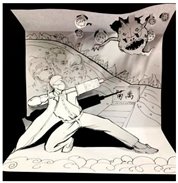 | 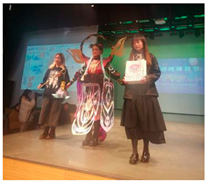 |
| B | 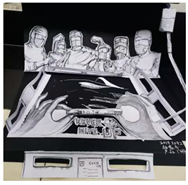 | 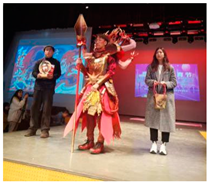 |
| C | 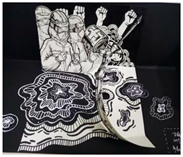 | 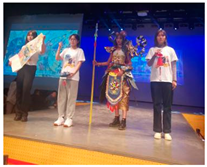 |
| D | 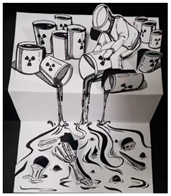 | 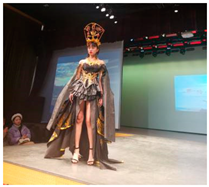 |
| E | 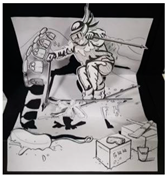 | 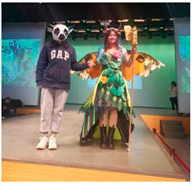 |
| F |  |  |
| G | 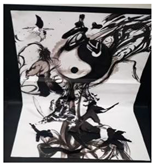 | 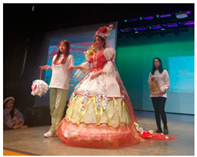 |
| H | 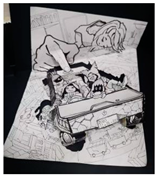 | 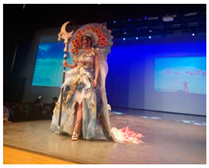 |
| I | 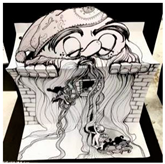 | 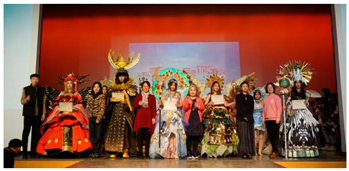 |
Publisher’s Note: MDPI stays neutral with regard to jurisdictional claims in published maps and institutional affiliations. |
© 2021 by the authors. Licensee MDPI, Basel, Switzerland. This article is an open access article distributed under the terms and conditions of the Creative Commons Attribution (CC BY) license (https://creativecommons.org/licenses/by/4.0/).
Share and Cite
Tu, J.-C.; Zhang, X.; Zhang, X.-Y. Basic Courses of Design Major Based on the ADDIE Model: Shed Light on Response to Social Trends and Needs. Sustainability 2021, 13, 4414. https://doi.org/10.3390/su13084414
Tu J-C, Zhang X, Zhang X-Y. Basic Courses of Design Major Based on the ADDIE Model: Shed Light on Response to Social Trends and Needs. Sustainability. 2021; 13(8):4414. https://doi.org/10.3390/su13084414
Chicago/Turabian StyleTu, Jui-Che, Xu Zhang, and Xiu-Yue Zhang. 2021. "Basic Courses of Design Major Based on the ADDIE Model: Shed Light on Response to Social Trends and Needs" Sustainability 13, no. 8: 4414. https://doi.org/10.3390/su13084414
APA StyleTu, J.-C., Zhang, X., & Zhang, X.-Y. (2021). Basic Courses of Design Major Based on the ADDIE Model: Shed Light on Response to Social Trends and Needs. Sustainability, 13(8), 4414. https://doi.org/10.3390/su13084414






